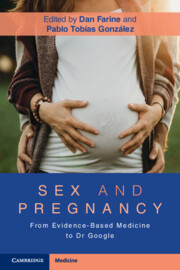Book contents
- Sex and Pregnancy
- Sex and Pregnancy
- Copyright page
- Dedication
- Contents
- Contributors
- Preface
- Section 1 General Issues
- Chapter 1 From Sex for Reproduction to Reproduction without Sex
- Chapter 2 Sex in Pregnancy
- Chapter 3 Physiology of Pregnancy As Related to Sex
- Chapter 4 Does Orgasm Affect Fetal Well-Being?
- Chapter 5 Demographics of Sexual Behavior in Pregnancy
- Chapter 6 Sexual Practices during Pregnancy in Different Cultures
- Chapter 7 What Do Obstetric Guidelines Say?
- Chapter 8 Using the Internet to Educate on Sex and Pregnancy
- Section 2 Specific Issues
- Index
- References
Chapter 1 - From Sex for Reproduction to Reproduction without Sex
from Section 1 - General Issues
Published online by Cambridge University Press: 09 November 2022
- Sex and Pregnancy
- Sex and Pregnancy
- Copyright page
- Dedication
- Contents
- Contributors
- Preface
- Section 1 General Issues
- Chapter 1 From Sex for Reproduction to Reproduction without Sex
- Chapter 2 Sex in Pregnancy
- Chapter 3 Physiology of Pregnancy As Related to Sex
- Chapter 4 Does Orgasm Affect Fetal Well-Being?
- Chapter 5 Demographics of Sexual Behavior in Pregnancy
- Chapter 6 Sexual Practices during Pregnancy in Different Cultures
- Chapter 7 What Do Obstetric Guidelines Say?
- Chapter 8 Using the Internet to Educate on Sex and Pregnancy
- Section 2 Specific Issues
- Index
- References
Summary
The level of awareness of one’s own sexuality and of its expression have always depended not only on a person’s stage of life but, first and foremost, on the specific cultural and religious milieus in which the person lives and operates. Since time immemorial, a special place in female sexuality has been reserved for the period of gestation, whether planned or unwanted. Becoming pregnant represents a unique time in a woman’s life, involving changes that are not only physical but also psychological. It is a period of change in a woman’s behavior and even sexual life, although we have entered an era of major evolution of the way we see sexuality and reproduction. Today, advances in reproductive medicine are progressively transforming basic human behavior in which the main emphasis has been on “sex for reproduction” into a situation where “sex without reproduction” is widely accepted. Finally, over the last few decades, “reproduction without sex” is increasingly taking hold. Indeed, an rising number of couples worldwide have been creating families where the offspring are the fruit of one of the many assisted reproduction technologies (ART). Therefore, reproduction without sex, looked at with suspicion and even open hostility only 30 years ago, has now entered a stage where it is considered a perfectly “natural” way of creating a family and – at least in the Western world – is increasing utilized by couples made by two individuals of the same genetic sex. Obviously, this new situation, not approved in a number of countries and perfectly legal in others, has created problems and is opposed by vocal groups with various arguments. The evolving relationship between sexuality and reproduction, the emergence of the new paradigm of reproduction without sex, with its influence on the two adult partners as well as on the offspring, will be briefly discussed from the point of view of its links to traditional sexuality, as well as taking into account the new options that are surfacing today.
Keywords
- Type
- Chapter
- Information
- Sex and PregnancyFrom Evidence-Based Medicine to Dr Google, pp. 1 - 7Publisher: Cambridge University PressPrint publication year: 2022

